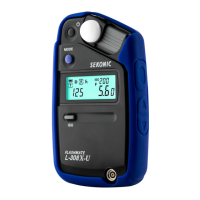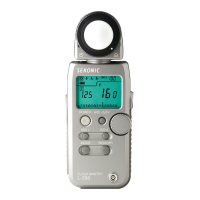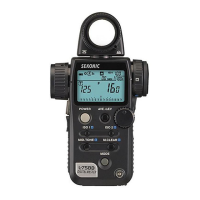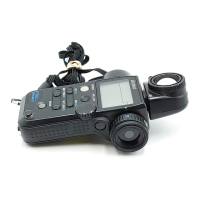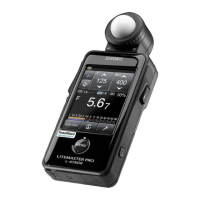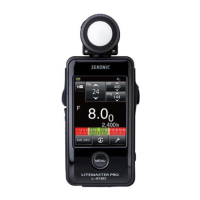Stage
4
Adiust
luminance
range
a.
Install Lumisphere.
b.
Hold meter at subject
position, point
Lumisphere toward camera
and
read
needle indication. With all
lights
turned
on, adjust
main light so that
indication
becomes
500
footcandles.
c. Set L
a
mark to
500 and
read H
r
mark
indicated value. This
value
becomes
16
to
indicate
luminance range
center
point.
lf
by
experience the
required results can be obtained
with a
lumi-
nance range of
16
to 1, a
maximum
luminance
indication
of 64
(center
point
16 x 4
=
64)
becomes the
upper
limit for
desired
color
reproduction. ln
this
case, the
minimum
limit
becomes
4
(center
point
16
+
4
=
4). This
means
that attractive
color
reproduction
cannot be obtained
unless the subiect
luminance
distribution
is within
4
-
64.
d.
Exchange
Lumisphere
for Lumigrid
and
check
if
there are
any
locations on
the
subject
brighter than 64
or dimmer than
4.
Stage 5
Determine correct
exposure
Although above Stage
4b
includes
an
exposure value
measurement
using the
Lumisphere,
perform
correct exposure
measurement as
a
final check.
With the illumination controlled as described,
this
should accurately
become
t15.6
'll50
sec. This 5 stage
procedure
allows
full
control
of all
lighting elements.
5. Closeups
It is essential to
increase the exposure
value
when the
subject
is
closer to the camera than
10 times the camera
focal distance.
An
example
of this type
of case
is with
a camera
lens
focal
distance
to
50mm and
a subject distance
of 4ocm. The
reason
for
this
is
the
increased image magnification as the subject
approaches
the
camera. When
light
from
the
subject
passes
through the
lens
and becomes
focussed
on the
film,
the
following relationship
exists
among
f
ilm
plane
illumination, subject brightness
and
image magni-
fication.
- a.rL 1
F=-
'-
4.F'
(M+llt-
E:
Film
plane
illumination
L: Subject
luminance
M:
lmage
magnif ication
F: F number
Tr
:
circular
constant
a: constant
As can
be
noted from
the above formula,
if
the subject luminance
is
fixed
and
the
magnification
changes,
the
film
plane
brightness
(illumination)
varies
in
the
inverse
proportion
(M
+
1)2. Witfr
a
large
subject
distance, M
is small
and this effect
becomes nearly
absent,
but
as the subject
distance
decreases, M
becomes larger.
In
an
actual
photographic
example,
with
a magnification
M
of
1,
film
plane
brightness
becomes
(M
+
1)2 or 4.
This is
1/4th that
of
a
subject
distance
at infinity
and exposure
must
be
increased
4
times.
When
the measured
exposure
value is
1/60
sec
shutter
speed,
this
must
be
compensated
to 1/15
sec
(1/60
x 4
=
1/15). In
closeup
photography,
(M
+
1)2 is
referred
to as the
compensation factor.
Measuring
Method
Hold
meter
as close
as
possible
to the
subject
and
point
Lumisphere
toward
the
camera.
lf
light
source
is
very
close
to the subject,
temporarily remove
the
subject
and hold
the Lumisphere
in
the
subject
position.
The
light
then
striking
the Lumisphere
becomes
exactly
the
same
as that illuminating
the
subject.
To obtain
exposure
compensation for
closeup:
1.
Determine
exposure
by
normal
incident
light
method.
2. Measure
subject
and
image
sizes
(groundglass).
3. lf the image
is larger
than
the subject, it
is enlarged,
while
a smaller image
is
compressed.
Divide
the larger
value
by the
smaller
value.
4.
Obtain
compensation factor
from
Table 1.
5.
Apply
compensation
factor
to measured
exposure
value
to
produce
compensated
exposure value.
32
.-,r=.r..i .,,urtir, .-.!":t:a\*,: . *,*-r, - -.,.. i;,r,-i*iki
"t
r..i!.i:r

